May 16, 2011
By Al Herum
Try dropping baits where there are no seasons. Hit the Florida Keys for deep drop grouper and snapper fishing.
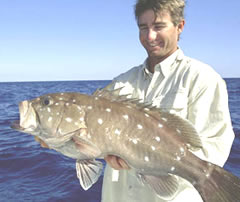
Zane Albury hooked a snowy grouper 700 feet below the boat.
|
The heavy sinker bumped bottom after plunging for over a minute. Zane Albury levered up the drag, took a few turns on the reel, and waited.
It didn't take long before his medium-duty standup rod bent deeply under pressure. As quickly as the fish hit, it was gone, then right back again for another try. Three swipes at the bait and the circle hook finally found its mark. Now, Albury was bowed up for real.
The fish zipped off a bit of line and then just stopped. We knew what species had that routine in its bag of tricks: It was a grouper, and it had us rocked up. Not a good place to be when you're separated from your quarry by more than two football fields of line and a strong current is pushing the boat away at over a knot.
We quickly pointed the boat upcurrent and motored over the top of the offending rockpile. Albury worked hard and managed to bust the fish loose from its hole after a few tries. Once free of the bottom, we returned to our northeast drift while Albury methodically pumped and wound to slowly bring his prize to the surface. I thought it would be prohibitively grueling to manually wind a large bottom fish up from a depth of over 700 feet. Albury told me while he was reeling the mystery fish to the surface, “It's not that bad as long as you take your time and just keep steady pressure on the fish. There's no rush once the fish is away from the bottom.”
It's inevitable that you'll hang a few rigs. |
|
Finally, I could see color coming up. The fish was still far down in the clear blue water. A minute later a hefty snowy grouper popped to the surface. Before it hit the ice we checked its weight on a certified scale: 22 pounds. Albury made a second drop on the same spot and managed another snowy that tipped the scales at 18. This spot had proven potential and we'd be back to try it again.
Albury's first fish turned out to be just 6 pounds off the current International Game Fish Association (IGFA) all-tackle world record for snowy grouper. Not bad for an experimental outing over unproven bottom. Albury, a Key Largo charter captain, and I have spent many days fishing together over the years—usually on tried-and-true reefs or bluewater edges. Our goal for this trip was to discover new bottom structure that might hold potential world record deepwater species like snowy grouper and queen snapper. We would look for rockpiles, ledges and ridges with our sounder and then sample the fish population by lowering a 3-hook rig with an electric reel. After confirming an area had some quality fish we'd drop the conventional gear or just save the numbers in our chartplotter for future investigation.
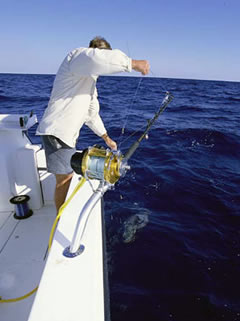
Electric reels coupled to stout, bent-butt rods simplify deepwater cranking chores.
|
To keep physical demands within reason, we limited our search to no deeper than 750 feet of water. We found productive ledges in the 700-foot range, several of which offered record fish potential—or at the least big-time entertainment. On one of our confirmation drops with the electrics we landed what would likely have been an all-tackle world record queen snapper. It weighed over 12 pounds on our certified hand scale. (Fish landed on electric outfits are ineligible for IGFA record certification.)
To find your own deep-drop spots, start your search by looking at a chart of your area to get a general idea of where the 500- to 750-foot depths are located and what kinds of contours they offer. Is it simply a straight dropoff or are there plenty of ups and downs with associated ledges? Areas with radical variations in bottom contour are the most promising. We found just such a stretch southwest of the Islamorada Hump, a prominent (and long fished) seamount in the Straits of Florida. Our chart showed large sections of bottom where the depths were right. Nearby were many hills and valleys. Remember, though, the resolution of a chart is limited and even the best bathymetric charts do not show every nook and cranny capable of holding fish. You'll need to get on the water and search with a sounder capable of reading deep water (1,000 watts output is a good start) to find the small spots, mark fish and learn the ledges.
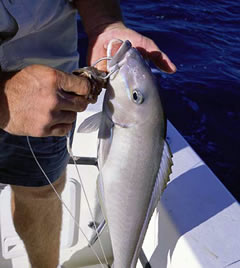
Tilefish readily inhale deep-drop baits.
|
When you find an area with potential, the first thing to do is record the numbers. That done, set up a drift and see how the current and wind combine to move the boat. Along much of the Florida Keys, for instance, you'll find the current takes you parallel to the reefline toward the north and east if the winds are light. Finding a ledge that runs in this direction for some distance can offer fantastic fishing, as you'll maximize your time over productive bottom. To confirm your spot really has some fish on it, you'll need to make a confirmation drop. It can be very difficult in these depths to mark fish—even those holding a fair distance above any structure—with most recreational sounders.
To save our energy for making record attempts on manual gear, Albury and I made all of our confirmation drops with an electric reel. We had stump-pulling, industrial-grade gear that consisted of a Penn 130 fitted with a Lindgren-Pitman 24-volt electric motor and a bent-butt boat rod specially designed for deep dropping. This is an expensive outfit capable of fishing depths far in excess of those we fished. Other deep-drop reels available from makers like Dolphin, Elec-Tra-Mate, Fish-Ng and Kristal are also quite capable and some are a bit less expensive as well.
Our 130 Penn was spooled with 1,000 yards of 130-pound Spectra to minimize the weight needed to hit bottom and maximize sensitivity for bite detection. The terminal end of the mainline we doubled with a Bimini twist and then secured to a large ball-bearing snap swivel with an offshore swivel knot. Our multi-hook probing rig had three circle hooks about 18 inches apart. One end of the rig we secured to the mainline with the snap swivel while the other end carried a window sash weight to get down fast. We baited up with bonito chunks and pieces of squid.
Once on the spot where we wanted to start the drift, the rig was sent down, allowed to hit bottom, then brought up just a few feet. The idea is to keep the rig very close to the bottom without hanging up and snagging. This requires an angler to man the rod at all times, constantly alert as to where the sinker is in relation to the bottom.
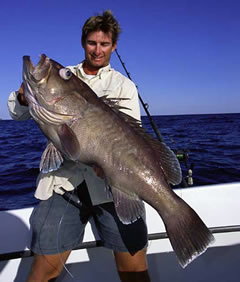
This snowy grouper weighed 22 pounds, only six shy of the all-tackle record.
|
It's inevitable you'll hang a few rigs and let me tell you it is not pretty. With tackle this heavy you basically anchor the boat when you hang a rig. Line just slowly peels off the reel as the boat drifts away. The first thing we'd do to try and free up the rig was to power the boat back upcurrent, getting straight up and down or even a bit upcurrent of the spot, and then increase the drag to the maximum the rod could handle—that worked on most occasions. If it didn't, we'd continue to hold the boat over the spot, back the drag all the way to freespool, then peel off enough slack line to secure the mainline to a stern cleat. It is simply too dangerous to try any other method to break off this heavy tackle. Once the line was secure on the cleat we powerdrifted with the current until the line parted. You only have to do this once before you begin to pay really close attention to your rig.
Gear for our record attempts was standard, conventional bottom fishing tackle. The only real modification consisted of topping off the reel with 300 yards of 50-pound Spectra. Even in strong current using the Spectra allowed us to drop to the bottom in 700 feet of water with 24 ounces of lead. Now that may sound like a bunch of lead, and it is, yet it's still far less than you'd need if you tried to drop monofilament line deep. Low-diameter braided line makes all the difference in deep water. Some adventurous anglers go even lighter than 50-pound braid, facilitating the use of deep-jigs on astonishingly light tackle.
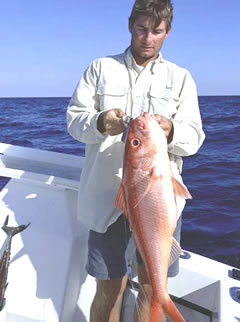
Queen snapper also attack deep baits.
|
For manual gear, Albury favors a single hook rig using a 3-way swivel with a length of leader commensurate with the strength of the current. Stronger current necessitates longer leaders and light current, shorter leaders. The day we fished, he fashioned a leader about 12 feet long for the fairly strong current. He secured the doubled mainline to one loop on the 3-way, a leader on another, and a short length of light mono holding lead to the third. The lead was attached with light line so in the event it hangs in the bottom it can be broken off easily.
Albury says bigger grouper will jump on a big bait presented on a single hook rig. Good baits for grouper include a dead, deboned speedo, small rainbow runner or large whole squid. Prime snapper baits are a bit smaller, for instance deboned ballyhoo, squid strip or whole small squid, and bonito or barracuda chunks. As with any bait, fresh is better than frozen.
In the Straits of Florida—as for pretty much any serious depths—there is no season. Just as the Gulf Stream remains constant throughout the year, so does deepwater fishing. Things just don't change down deep based on what happens several hundred feet above on the surface. Deepwater grouper and snapper fishing is a year-round fishery best enjoyed when calm seas permit an easy run to the depths.
One thing that keeps bottom fishermen coming back for more time after time is the suspense of not knowing what they'll pull up on the next drop. Grinding a fish up by hand from 500, 600 or even 700 feet is certainly doable and does not require superhuman strength or stamina. Give it a try; even if you don't seek world records, most deepwater species make fine tablefare. FS
First Published Florida Sportsman August 2005
About the Author
Regulations for Deep Drop Grouper and Snapper:
Florida State Waters
South Atlantic Federal Waters
Gulf of Mexico Federal Waters
